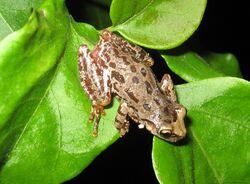Biology:Julianus (frog)
| Julianus | |
|---|---|

| |
| Julianus uruguayus | |
| Scientific classification | |
| Domain: | Eukaryota |
| Kingdom: | Animalia |
| Phylum: | Chordata |
| Class: | Amphibia |
| Order: | Anura |
| Family: | Hylidae |
| Tribe: | Dendropsophini |
| Genus: | Julianus Duellman, Marion & Hedges, 2016 |
| Type species | |
| Scinax uruguayus (Schmidt, 1944)
| |
| Species | |
|
2 species (see text) | |
Julianus is a genus of tree frogs in the family Hylidae.[1] They are found in southeastern Brazil , Uruguay, and northeastern Argentina .[2][3] This genus is considered poorly defined and is regarded by most to merely be a synonym of Scinax.[4]
This genus is named after Julián Faivovich, who has contributed a notable amount of knowledge to the study of South American tree frogs.[1] It was created because Scinax uruguayus differed from other Scinax in the larval oral disc morphology.[1] More specifically, the tadpole has two keratinized and pigmented plates on the lower jaw sheath, along with the posterior marginal papillae being larger than the papillae on the lateral margins.[5] The species Julianus pinimus was later added to this genus due to having similar features.
However, other papers claim that these frogs are not distinct enough to be grouped into an entirely different genus and should be readded to Scinax. This is because many of the characteristics used to define this genus are shared by other members of Scinax as well.[4][6]
Species
There are currently two species in Julianus:[1]
- Julianus uruguayus Schmidt, 1944
- Bokermann & Sazima, 1973 Julianus pinimus
J. uruguayus is known from Treinta y Tres, Cerro Largo, and Tacuarembó in Uruguay, along with Santa Catarina, Brazil , and Corrientes, Argentina .[2] It may also occur in parts of Paraguay, but this is unconfirmed. J. pinimus is only known from a single locality in Minas Gerais, Brazil .[3]
Wikidata ☰ Q25396798 entry
References
- ↑ 1.0 1.1 1.2 1.3 Duellman (19 April 2016). "Phylogenetics, classification, and biogeography of the treefrogs (Amphibia: Anura: Arboranae)". Zootaxa 4104 (1): 1–109. doi:10.11646/zootaxa.4104.1.1. PMID 27394762. http://www.cnah.org/pdf/88524.pdf.
- ↑ 2.0 2.1 "Scinax uruguayus (Schmidt, 1944)". https://amphibiansoftheworld.amnh.org/Amphibia/Anura/Hylidae/Scinaxinae/Scinax/Scinax-uruguayus.
- ↑ 3.0 3.1 "Scinax pinimus (Bokermann and Sazima, 1973)". https://amphibiansoftheworld.amnh.org/Amphibia/Anura/Hylidae/Scinaxinae/Scinax/Scinax-pinimus.
- ↑ 4.0 4.1 Baldo (25 September 2019). "A review of the elusive bicolored iris Snouted Treefrogs (Anura: Hylidae:Scinax uruguayus group)". PLOS ONE 14 (9): e0222131. doi:10.1371/journal.pone.0222131. PMID 31553727. Bibcode: 2019PLoSO..1422131B.
- ↑ Faivovich (24 June 2005). "Systematic review of the frog family Hylidae, with special reference to Hylinae: phylogenetic analysis and taxonomic revision". Bulletin of the American Museum of Natural History 294: 1. doi:10.1206/0003-0090(2005)294[0001:SROTFF2.0.CO;2]. https://digitallibrary.amnh.org/bitstream/handle/2246/462/B294.pdf?sequence=1.
- ↑ Faivovich (23 April 2018). "On the Monophyly and Relationships of Several Genera of Hylini (Anura: Hylinae), with Comments on Recent Taxonomic Changes in Hylids". South American Journal of Herpetology 13 (1): 1–32. doi:10.2994/SAJH-D-17-00115.1. https://ri.conicet.gov.ar/bitstream/handle/11336/94370/CONICET_Digital_Nro.1c2bb6bb-b760-4d07-a9e6-8a6329f70f4f_D.pdf;jsessionid=08E07B004001B96BEF22B8FBB49CB555?sequence=5.
 |

